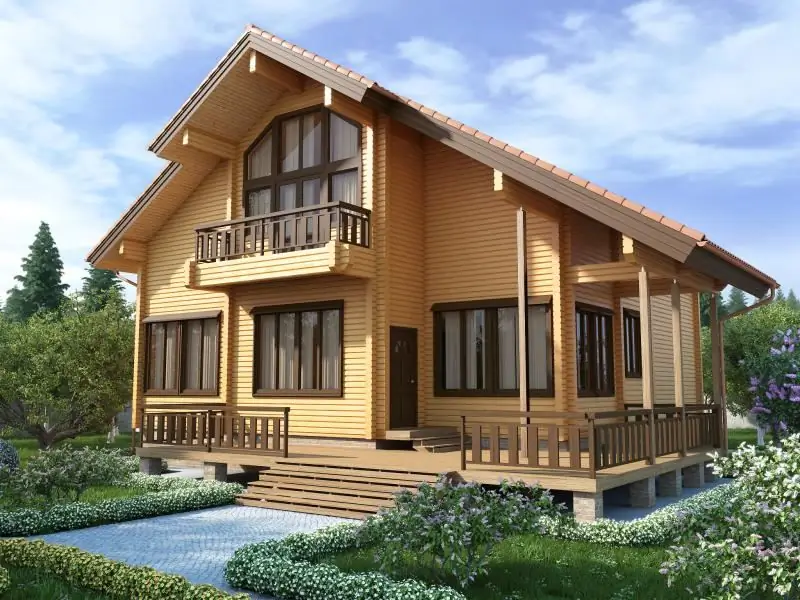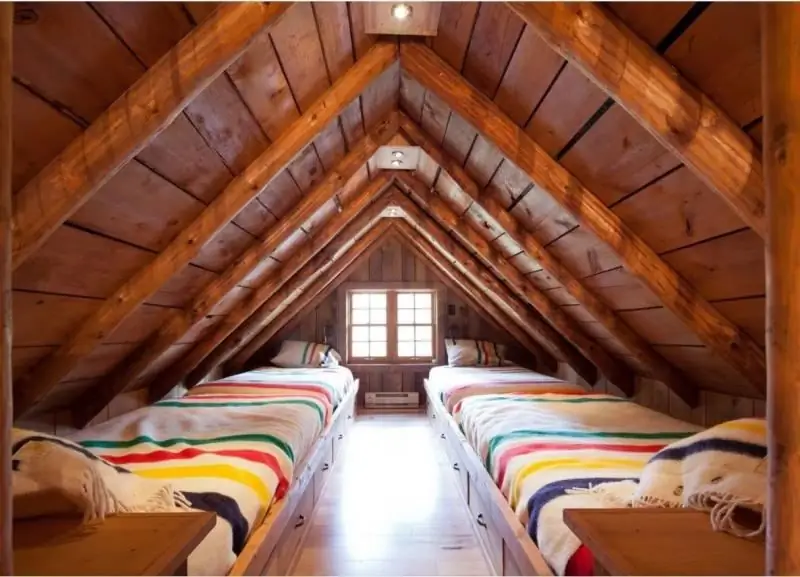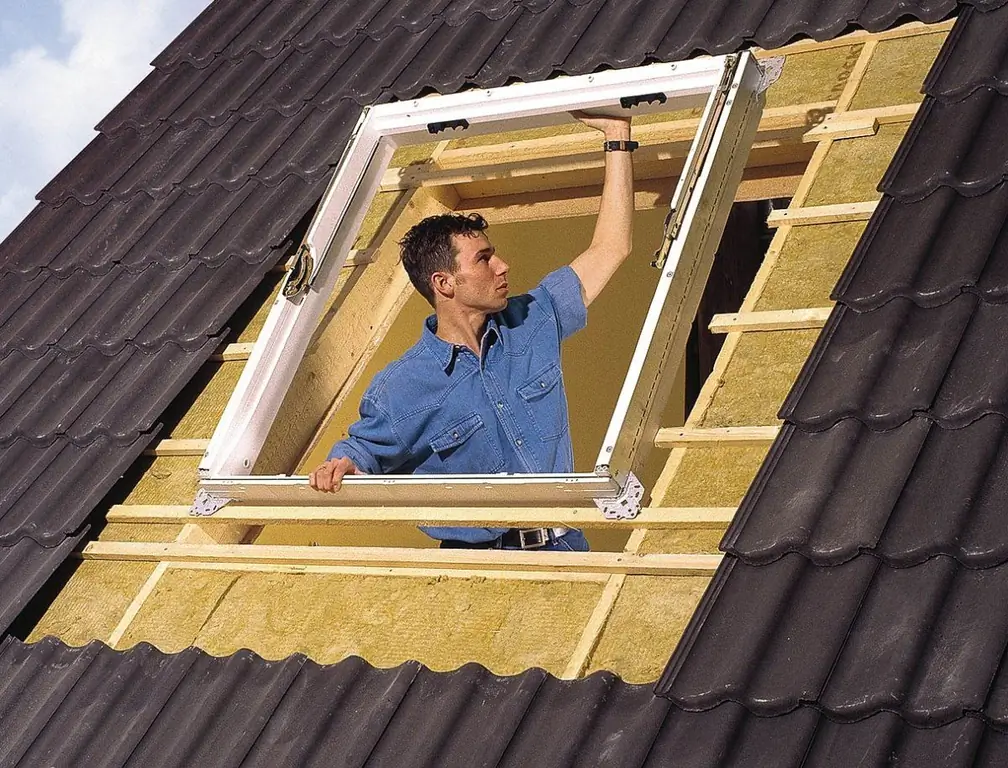
Table of contents:
- Author Bailey Albertson [email protected].
- Public 2023-12-17 12:53.
- Last modified 2025-06-01 07:32.
Insulation of the attic roof: the material used and the features of its installation

The attic floor is often used for housing, so it is necessary to carry out the insulation correctly in order to create comfortable conditions. The technology is similar to similar work in any other room, but the peculiarity is that the attic is separated from the street by gables and a roof, and not by main walls. All surfaces need to be insulated, and since they differ in the device, the installation of the insulation is carried out in different ways.
Content
-
1 The better to insulate the attic roof
- 1.1 Materials for insulation
- 1.2 The better to carry out insulation of the attic roof from the inside
-
2 How to properly insulate the roof of the attic
- 2.1 Features of installation of insulation for the attic roof
- 2.2 Video: insulation of the attic roof from the inside
- 3 Insulation of the attic gable outside
- 4 Video: insulation of the attic pediment
The better to insulate the attic roof
Usually, on the attic floor there are no load-bearing walls with high thermal insulation characteristics, therefore, the insulation of the roof and gables should be carried out especially carefully and efficiently. This is the only way you can feel comfortable and cozy in the attic both in summer and in winter.
If we compare the roof of the attic room and the main walls, it is clear that it cannot compete with them in thermal insulation. In addition, the roof cannot withstand heavy loads. All this must be taken into account when choosing a heater.

A properly insulated attic room can significantly increase the living area of the house
In order to maximize the useful volume of the attic floor, the following rules must be followed during its construction:
- to reduce the load on the rafter system, light roofing materials are chosen, in this case it is not recommended to use natural tiles;
- to reduce the layer of roofing cake, modern and effective thermal insulation materials are chosen;
- special attention is paid to the organization of ventilation of the roofing space, otherwise moisture will accumulate in the room and the thermal insulation properties will deteriorate.
Correctly executed ventilation and waterproofing of the attic roof allows moisture to be removed from under the roof space, which ensures effective thermal insulation and a long service life of the materials used

For a mansard roof, it is necessary to choose light materials
The choice of insulation depends on the number of layers required and the thickness of the heat-insulating "pie". The attic has its own design features, so the insulation must meet the following requirements:
- have low thermal conductivity, experts recommend using materials with a coefficient below 0.05 W / m * K;
- due to possible roof leaks, the insulation must be moisture resistant and lose a minimum of its properties after getting wet;
- have a low weight so as not to overload the rafter system, it depends on the density of the material, which should be in the range of 14-50 kg / m 3, it is not recommended to use denser insulation;
- should not burn and support combustion;
- since the thermal insulation material is laid on the roof, this requires that it keep its shape well and does not creep over time, forming gaps;
- withstand significant temperature changes, not be afraid of frost;
- have a long service life.
Insulation materials
For the insulation of the attic roof, the following materials are most often used:
-
Mineral wool. This is an excellent solution, it does not burn and does not support the combustion process, it is easy to fit, has a low weight, high thermal insulation characteristics. In addition, mineral wool has an affordable cost, therefore it is popular and in demand. Depending on the region where the building to be insulated is located, the thickness of its layer can be from 150 to 300 mm. The main disadvantage is that this material absorbs moisture well, so high-quality waterproofing must be done.

Mineral wool Mineral wool can be in rolls and mats, it is more difficult to insulate the roof with roll materials
-
Styrofoam or expanded polystyrene. This material is lightweight, has good thermal insulation characteristics, low moisture permeability, but its main drawback is a high degree of fire hazard. During the laying of the foam, it crumbles, so there are gaps that must be additionally sealed. After some time, the foam, unprotected from external factors, begins to gradually deteriorate, therefore experts do not recommend insulating the attic with this material.

Styrofoam To insulate the attic, it is necessary to use polystyrene with a thickness of at least 50 mm, if necessary, it can be laid in several layers
-
Extruded polystyrene foam. This is a good insulation for carrying out these works, since it is durable, not afraid of moisture, does not burn and keeps its shape well. A sufficient layer of material is 5-10 cm. Extruded polystyrene foam has low vapor permeability, therefore, in order to create comfortable conditions in the attic, it is necessary to properly supply and exhaust ventilation, and this is additional time and costs. In addition, its price is higher than that of conventional foam.

Exterior view of the attic roof, insulated with extruded polystyrene foam When insulating a roof with extruded polystyrene, good ventilation is required
-
Polyurethane foam. For installation, special equipment is used, which makes it possible to apply the material without cracks and gaps. It has good thermal insulation characteristics, light weight, does not burn, moisture-proof, but its disadvantage is low vapor permeability. Without the organization of forced ventilation, it will be uncomfortable to be in such a room due to high humidity.

Attic insulation with polyurethane foam It will not be possible to carry out the work on insulation with polyurethane foam on your own, since professional equipment is needed
-
Ecowool. This is the most suitable material for attic insulation. It is also applied without gaps, penetrates into all cracks and fills them well, is not afraid of moisture, does not burn, has a low weight and good vapor permeability, and is environmentally friendly. In addition to the fact that the cost of this material is high, it will not be possible to insulate the attic with ecowool on your own, therefore, to perform these works, you will have to invite specialists.

Thermal insulation of the attic with ecowool Special equipment is used to apply ecowool
-
Foil materials. They not only insulate the room, but also reflect heat. In order for such materials to effectively fulfill their purpose, the mirror layer must be directed towards the inside of the attic. A gap of about 5 cm is left between the insulation and the vapor barrier.

Foil insulation penofol Foil insulation is used for hydro, heat and sound insulation
In each case, the choice of the most effective insulation for the attic must be approached individually. When using mineral wool, the thermal insulation "pie" can be disassembled, the condition of the rafters can be assessed and, if necessary, repair work can be carried out, and then everything can be put back in place. If sprayed materials were used, then it will not work to inspect the rafters.
The better to insulate the roof of the attic from the inside
When choosing materials for insulating the attic from the inside, the climatic conditions in which the house is located are taken into account. Each material has its own pros and cons. The most popular and affordable material with which the attic is insulated from the inside is basalt wool. Installation is carried out in several layers, while overlapping the seams. Usually a 15-20 cm layer is sufficient.

Basalt wool is laid in several layers
Professionals often use polyurethane foam. It has high adhesion, so there are no gaps left after application. Polyurethane foam has high thermal insulation characteristics, so it is applied in a smaller layer, unlike other materials, which will need much more. But keep in mind that the cost of the specified material is high and installation will not work without special equipment. Polystyrene foam plates are often used, the thickness of the required layer will depend on the density of the material used.
If you carry out the insulation of the attic roof from the inside yourself, then it is best to use expanded polystyrene, basalt or mineral wool, since they are easy to install. Often they are combined: first, mineral wool is laid, and then expanded polystyrene plates.
How to properly insulate the roof of the attic
The technology for carrying out these works is not difficult, especially if the insulation is carried out with mineral wool. During the installation of thermal insulation, personal safety measures must be observed: be sure to wear tight and closed clothing, use glasses, gloves and a respirator.
Sequence of work:
-
Preparatory stage. All wooden surfaces are well treated with antiseptics, metal parts are coated with anti-corrosion impregnation.

Roof treatment with antiseptic Treatment of wooden roof elements with an antiseptic can significantly increase their service life
-
Fastening waterproofing. A waterproofing film is fixed on the rafters, and a crate is mounted on top. The waterproofing material is laid with an overlap between the battens and the rafters, all seams are glued with a mounting foil, for example, "Ondutis BL" or "Ondutis ML". First, the tape is attached to the canvas located at the bottom, this is done 5-6 cm from the edge, then the protective layer is removed from the tape and the upper canvas is fixed. The material is laid from the lower roof slope. First, the film is fixed with a stapler, and then wooden counter-battens are installed to create a ventilation gap. You can fasten the slats to the rafters with nails or powerful staples, but it is better to do this with self-tapping screws. Then proceed to the installation of insulation.

Laying of layers of thermal insulation Insulating layers are laid in a certain sequence.
- Installation of insulation. Insulation is laid between the rafters, work starts from the bottom and gradually moves up. In order for the insulation to fit tightly, its size should slightly exceed the distance between the beams. To fix the insulation, special anchors or frost-resistant glue are used. This applies to roll and slab insulation, such as mineral wool, polystyrene foam and polystyrene foam. Ecowool and polyurethane foam are applied using a special installation, so there are no empty voids left.
- Mounting the vapor barrier. After laying the last layer of insulation, the vapor barrier is installed. It is mounted on a wooden lathing, laid on an insulating layer. It is not necessary to tighten the vapor barrier membrane too much, it should sag by 2-3 cm, this will provide a ventilation gap between the thermal insulation and the outer finish.
-
The final stage is the installation of finishing materials. To do this, a crate is made over the laid vapor barrier, you can use wooden slats or a metal profile, and already on it with the help of special screws, sheets of drywall, plywood, chipboard or lining are fixed.

Plasterboard installation Installation of drywall is carried out on a metal or wooden crate, which is attached to the rafters on top of the vapor barrier
When installing the insulation, the plates should be tightly adjacent to each other, and to eliminate cold bridges, it is recommended to lay a second layer with overlapping joints
Useful tips for choosing and installing various types of insulation:
- if mineral wool or fiberglass is used, then to ensure high thermal insulation characteristics, their layer should be 15-20 cm;
- basalt wool can withstand temperatures up to 1000 ° C, does not absorb moisture, but it is damaged by rodents;
- A 2.5 cm layer of polyurethane foam in terms of its thermal insulation characteristics corresponds to an 8 cm layer of mineral wool;
- A 15-cm layer of ecowool in terms of thermal insulation characteristics corresponds to a 50-cm layer of wood;
- in order for the rolled or slab material to lie tightly between the rafters, its width should exceed the distance between them by 1-2 cm.
Features of installing insulation for the attic roof
When designing a building with an attic floor, it is necessary to correctly calculate the distance between the rafters in order to ensure maximum structural strength. When installing insulation between the rafters, it is necessary to lay the material end-to-end so that there are no gaps, otherwise cold bridges will form.

Only the correct laying of all elements will allow you to effectively insulate the attic
During the installation of waterproofing, all work is performed from the lower roof slope and the material is overlapped. On top of the insulation mats, it is recommended to lay another continuous layer that completely covers the rafters. Wooden or metal rafters have a higher thermal conductivity than insulation and are cold bridges. If they are covered with insulating material, it will be inconvenient to mount the finishing elements. To simplify this task, it is necessary to mark the location of the rafters during the installation of the last layer of insulation.
If we talk about the insulation of the attic roof from the inside, then not all materials are convenient to mount, roll insulation is almost impossible to install normally. To strengthen the rafter system, various connections are often used, which complicate the installation of the insulation layer.
Video: insulation of the attic roof from the inside
Insulation of the attic gable outside
When insulating the gable from the outside, most specialists and home craftsmen use extruded polystyrene foam or ordinary foam. To perform these works, scaffolding will be needed, since it will be difficult, long and tedious to do everything with a ladder.
The gable insulation technology from the outside consists of the following stages:
- First, the walls are prepared. To do this, they are cleaned of dirt, and then primed. The primer will allow the adhesive to perform better. It is recommended to prime in two layers, the second is applied after the first has dried.
-
If you plan to use such a finishing material as siding, then for its fastening it is necessary to make a crate. It can be made of wooden beams or galvanized profiles. The height of the crate should correspond to the thickness of the insulation used.

Pediment lathing To make it easier to install the foam, the step of the crate should be equal to the width of the sheet, then the material will fit tightly and waste will be minimal
- A sheet of foam in the corners and in the center is lubricated with glue and pressed for 30-35 seconds to the surface of the pediment.
-
If the foam will be plastered, then it is better to additionally fix it with plastic dowels.

Installation of foam If the foam is plastered, it must be fixed with dowels, and if siding is being mounted, then fixing with only glue is enough
- After laying the insulation, a waterproofing film is attached. If the lathing is wooden, then this is done with a stapler, and it is fixed to the profile with a counter lattice, on which the siding is then attached. To create a gap between the waterproofing and the decorative finish, the thickness of the battens should be 20-30 mm.
-
At the last stage, the siding is installed or the foam is plastered and then painted.

Siding installation Both metal and vinyl siding can be used to finish the gable.
Video: insulation of the attic pediment
It is not difficult to insulate the attic with your own hands, it is enough to have basic knowledge and skillful hands. If we talk about the insulation of the pediment, then when using a curtain facade it is better to take such an insulating material as mineral wool. If the facade is wet, then it is better to insulate with foam. Only with the observance of the developed technologies and the correct implementation of the stages of work on the attic insulation will the expected result be obtained. If everything is done correctly, then you can use the attic as a living space throughout the year.
Recommended:
Insulation For The Roof - Which Is Better: Types With Descriptions, Characteristics And Reviews

Types of roof insulation: polystyrene, expanded clay, polystyrene foam, basalt and mineral wool. Differences between roll, plate and bulk materials. Owner reviews
The Structure Of The Roof Of A Wooden House, Including The Main Nodes Of The Roof, As Well As What Material Is Better To Use

Roof device of a wooden house. The main units, elements and types of roofing. Insulation, decoration, repair and replacement of the roof of a wooden house
What Kind Of Insulation To Choose For The Attic Roof, As Well As The Calculation Of The Required Material

What kind of insulation can be used for thermal insulation of the attic. Calculation of the required thickness of the material and the technology of its installation inside and outside the room
How To Make An Attic, Including On An Old House, As Well As Remodeling A Roof For An Attic Floor

Can the roof of an old house be converted into an attic? How to do it yourself. Features of the device and design calculation
Installation Of Roof Windows, Including With Your Own Hands, As Well As Installation Features In An Already Finished Roof

Step by step instructions for installing a roof window. Features of technology and nuances of installation in various types of roofing
